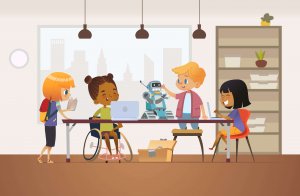Using Methods to Support Inclusion with Kids


Written and verified by the psychologist Ana Couñago
Using methods to support inclusion at school is the first step to instilling respect for diversity in society. At school, kids learn from a young age to live together, understand, communicate and relate to all kinds of people, regardless of their background or personal circumstances.
So, using these educational strategies has a positive impact on students, families and teachers at school.
Using methods to support inclusion
Students are the main group that is directly influenced by inclusion at school. To achieve this, it’s important to let students:
- Access the media center without being segregated. This means without them being sent to other schools based on their characteristics or needs.
- Have unrestricted access to certain spaces, resources and educational possibilities.
In addition, schools need to recognize diversity. That way, kids learn a series of ethical values, like:
- Justice. Wanting for others what you want for yourself.
- Kindness. Worry about the most vulnerable people.
- Criticism. Recognize and help overcome barriers that limit your own and other’s wants.
- Responsibility.

So, students need to learn these values and show that they’re open to collaborate at school. Then, they need to participate and show a positive attitude in the learning process.
Therefore, you need to create a sense of collaboration and cooperation in the classroom. Then, promote working in heterogenous groups. This way, classmates become active resources of support and learning for each other.
Teachers must use methods to support inclusion
For these inclusive practices to happen, teacher training and professional development are very important. Then, teachers must learn to teach all kinds of children so they can learn the best ways to teach them.
Therefore, teachers need to value the capacities and characteristics of all students, especially those with specific educational needs. So, they should learn about methods to support inclusion, and choose the ones that best suit the classroom circumstances.
Also, teachers need to plan the strategies so that everyone can participate in their own learning. To get good results, teachers need to take three essential steps:
- Plan each activity carefully.
- Give students opportunities to work together.
- Supervise group tasks from a distance, taking on the role of a facilitator.
However, for all of this to work, there needs to be a team at the school that believes in inclusion. There needs to be good organization and coordination. Also, the leadership of the principal is very important.

The family in inclusive education
In addition, the school needs to maintain fluid communication with students’ families, based on listening and mutual respect. It’s essential that they feel welcomed and valued, that they’re a part of the decisions and activities. Also, they need to feel like they can get involved and support as much as possible.
Therefore, you have to know the points of agreement and disagreement in educational practices so teachers and families can work together confidently. In short, to support inclusion, these three forces need to commit to work together:
- Students
- Families
- Teachers
Finally, inclusive classrooms need to have an inclusive culture. In these schools, they value:
- Equality among all students.
- Respect for differences.
- Parental involvement.
- The active presence of students in the learning process.
Using methods to support inclusion at school is the first step to instilling respect for diversity in society. At school, kids learn from a young age to live together, understand, communicate and relate to all kinds of people, regardless of their background or personal circumstances.
So, using these educational strategies has a positive impact on students, families and teachers at school.
Using methods to support inclusion
Students are the main group that is directly influenced by inclusion at school. To achieve this, it’s important to let students:
- Access the media center without being segregated. This means without them being sent to other schools based on their characteristics or needs.
- Have unrestricted access to certain spaces, resources and educational possibilities.
In addition, schools need to recognize diversity. That way, kids learn a series of ethical values, like:
- Justice. Wanting for others what you want for yourself.
- Kindness. Worry about the most vulnerable people.
- Criticism. Recognize and help overcome barriers that limit your own and other’s wants.
- Responsibility.

So, students need to learn these values and show that they’re open to collaborate at school. Then, they need to participate and show a positive attitude in the learning process.
Therefore, you need to create a sense of collaboration and cooperation in the classroom. Then, promote working in heterogenous groups. This way, classmates become active resources of support and learning for each other.
Teachers must use methods to support inclusion
For these inclusive practices to happen, teacher training and professional development are very important. Then, teachers must learn to teach all kinds of children so they can learn the best ways to teach them.
Therefore, teachers need to value the capacities and characteristics of all students, especially those with specific educational needs. So, they should learn about methods to support inclusion, and choose the ones that best suit the classroom circumstances.
Also, teachers need to plan the strategies so that everyone can participate in their own learning. To get good results, teachers need to take three essential steps:
- Plan each activity carefully.
- Give students opportunities to work together.
- Supervise group tasks from a distance, taking on the role of a facilitator.
However, for all of this to work, there needs to be a team at the school that believes in inclusion. There needs to be good organization and coordination. Also, the leadership of the principal is very important.

The family in inclusive education
In addition, the school needs to maintain fluid communication with students’ families, based on listening and mutual respect. It’s essential that they feel welcomed and valued, that they’re a part of the decisions and activities. Also, they need to feel like they can get involved and support as much as possible.
Therefore, you have to know the points of agreement and disagreement in educational practices so teachers and families can work together confidently. In short, to support inclusion, these three forces need to commit to work together:
- Students
- Families
- Teachers
Finally, inclusive classrooms need to have an inclusive culture. In these schools, they value:
- Equality among all students.
- Respect for differences.
- Parental involvement.
- The active presence of students in the learning process.
All cited sources were thoroughly reviewed by our team to ensure their quality, reliability, currency, and validity. The bibliography of this article was considered reliable and of academic or scientific accuracy.
- Booth, T. y Ainscow, M. (2015). Guía para la educación inclusiva: desarrollando el aprendizaje y la participación en los centros escolares. Madrid: OEI.
- Marchesi, A. (2012). La práctica de las escuelas inclusivas. En Á. Marchesi, J. P. González y C. Coll (Ed.), Desarrollo Psicológico Y Educación: 3. Transtornos Del Desarrollo Y Necesidades Educativas Especiales (pp. 45-67). Madrid: Alianza Editorial.
- Sandoval, M., Echeita, G., Simón, C. y López, M. (2012). Educación Inclusiva. Iguales en la diversidad. Madrid: Ministerio de Educación, Cultura y Deporte, INTEF.
This text is provided for informational purposes only and does not replace consultation with a professional. If in doubt, consult your specialist.








